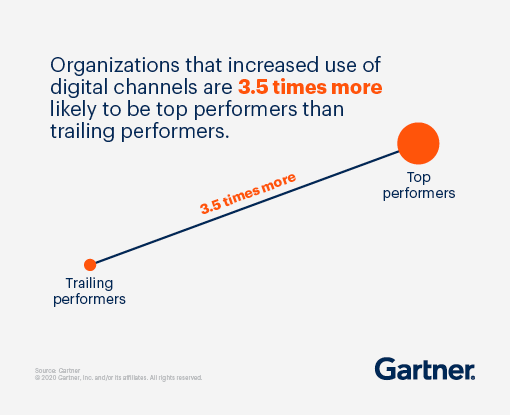
12 Statistics to Inspire You To Take the Next Steps (Big or Small) And Move Your Call Center to the Cloud
As many as 20% of Fortune 500 companies won’t make it through 2021 in one piece.
Saddled with technical debt and bureaucratic processes that slow down decision-making, Forrester predicts many top-tier companies will sell off pieces of their business or merge with others to stay viable.
The unexpected challenges of 2020 brought existing business gaps into clear view. But because of these realizations, we’re seeing new, promising trends in technology and processes emerge.
[Download Now] 7 projects for you and your VP of Ops to improve call center efficiency
Company leaders found clarity in obstacles. They ditched old methods and moved faster, for the sake of employees and customers. Cloud adoption ticked up, and skepticism plummeted.
In fact, Gartner found that 69% of boards plan to accelerate digital business initiatives in response to COVID. And in 2020, some 27% of companies reported improvements in the quality of their customer service, up from only 14% in 2019.
Decisions to change technology or update processes took months, sometimes even weeks, instead of years. And our resilience grew.
Now, leaders like you are certainly looking ahead, making strategic decisions about what’s next as cloud migration accelerates. To help, we’re sharing 12 statistics on cloud technology, so you can stay inspired to keep the momentum going.
Whether you’re still a skeptic or you’ve jumped aboard the move to the cloud, these statistics are for you.
1. The infamous year 2020 sent customer complaints soaring. In a study of more than 1 million customer service calls, companies reported 34% increases in hold times and 68% rises in escalations. (Tethr)
Supporting a smooth move to the cloud lets you adopt customer service tools built for the new-age customer experience. You can add channels and coach on the fly to build in more efficiency and confidence for your team, so you keep hold times and escalations at bay even during the toughest times.
[Watch Now] Blackhawk Network improved agent efficiency by 12% after moving agents home
2. By 2022, 65% of CIOs will give frontline workers access to data and knowledge to help their productivity and decision-making in the face of change. (IDC)
Customer data is the nucleus of your contact center. Leading companies have plans in motion to give frontline workers, like salespeople and your agents, more access to data to inform their conversations. The more investments in cloud CRMs and ticketing systems, the harder it will become to integrate and share customer data with legacy call center systems.
3. Integrated coaching, coaching that happens immediately after calls, can improve team performance by 12%. And, the best managers spend 75% of their time coaching in-the-moment. (HBR)
Traditional contact center tools typically don’t offer the flexibity to coach in-the-moment and give your agents direction throughout the day. When you invest in modern cloud tools, you invest in improved agent performance and happier customers.
4. By 2022, 70% of all companies plan to accelerate the use of digital technologies to improve business processes, customer engagement and employee productivity. (IDC)
Digitalizing your business is inevitable. In today’s world, it’s simply too hard to meet customer expectations and maintain the efficiencies you need without support from better technology. Why wait?
“The road ahead will certainly have challenges… But there’s also a tremendous amount of hope because of the doors that a digital-first strategy can open.”
5. Companies that invest in operational and IT improvements to help their customers see financial gains from 20-50% above cost. (McKinsey & Company)
Your customer and agent-focused investments in modern cloud technology will deliver ROI. Period.
[Learn More] Get 5-15% ROI with Sharpen in 60 days or your money back
6. Remote work won’t vanish any time soon. By the end of 2021, the number of remote workers will sit at 3x pre-pandemic levels. (Forrester)
Supporting remote workers and continuing to meet customer expectations doesn’t have to give you headaches. Moving to the cloud eliminates at least one (maybe take breaks from the news to get rid of a few more).
7. More than 82% of consumers (of all ages!) now feel comfortable using digital channels to solve at least some service issues. (CCW)
Changes in customer behavior require changes in your business model, too. Further, as customers take advantage of the convenience of digital channels, it’s on you to make sure your customer experience is equipped to support the new expectations.
8. What’s more? Another 86% of consumers want to solve problems on their own with chatbots, videos, and even your IVR. (CCW)
As you continue to adopt digital channels, cloud contact center tools let you iterate and improve, without tagging in IT. With drag and drop tools for call routing, omnichannel IVRs and bots, some cloud vendors (ahem…. Sharpen) give managers like you the power to make changes in minutes that would typically take two weeks and an IT tag-team to solve.
9. The top challenges for contact centers in 2021 revolve around supporting agents and improving efficiencies to keep up with customer demands. Some 28% of contact center leaders said too many interactions and too few agents is their number one challenge. The number 2 challenge? Supporting remote workers. (Strategic Contact)
In Strategic Contact’s annual challenge & priorities survey, contact center leaders said abandon rates, lack of coaching and development and high contact volumes plague 2021 call centers. Moving to the cloud means building efficiencies into your coaching, your agent interface and your operational processes, so you can keep up with higher volumes and continue to provide quality service, even without extra budget for more headcount.
“Improving the agent desktop still sits atop many contact center “wish lists.” Too often, the agent is the point of integration amidst several isolated applications and user interfaces. Fixing the desktop can have a huge impact on handle times, customer experience, and employee engagement.”
10. Leading companies reallocate talent and capital 4x faster than their peer groups. (McKinsey & Company)
The cloud builds agility into your business operations, so you can make strategic decisions faster.
[Read Next] How to prepare for the future of customer service
11. Companies who increase their digital channels are 3.5x more likely to be top performers. (Gartner)

This sentiment echoes much of the rest. Companies who put their decisions behind digital see greater dividends.
12. Through 2023, some 70% of CIOs will face financial strain in coping with technical debt because of the pandemic. (CIO)
Companies that didn’t have a business continuity plan in 2020 are stuck playing catch-up. And they’ll be cleaning up their processes and operations for at least the next two years. If you’re struggling to get buy-in on moving to the cloud, share this statistic. Encourage leaders to invest in the move to the cloud now, so you aren’t stuck playing catch-up five years from now.
[Download Now] 7 projects for you and your VP of Ops to improve call center efficiency

